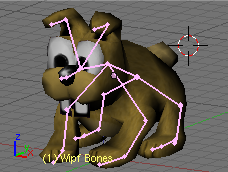About: Difference between revisions
No edit summary |
|||
| Line 7: | Line 7: | ||
New in OpenClonk is the possibility to '''zoom''' in and out. Now, the clonk can be displayed in a proper size, larger than a mouse cursor ;-). | New in OpenClonk is the possibility to '''zoom''' in and out. Now, the clonk can be displayed in a proper size, larger than a mouse cursor ;-). | ||
Also new is the possibility to add '''3d models''' to be rendered ingame. As opposed to the classic sprite graphics, 3d models are much more versatile: First, the models don't get blurry and the animations don't seem edgy when zoomed in. Animations don't need to be pieced together from single renderings in different animation phases and then exported into a big Graphics.png anymore. The renderer loads models in the Ogre 3D format, a lightweight format for 3d models tailored to be rendered in realtime. It projects models in the landscape orthographically and pictures of objects perspectively. Apart from the basic stuff, the renderer supports: | [[File:bones.png|right]]Also new is the possibility to add '''3d models''' to be rendered ingame. As opposed to the classic sprite graphics, 3d models are much more versatile: First, the models don't get blurry and the animations don't seem edgy when zoomed in. Animations don't need to be pieced together from single renderings in different animation phases and then exported into a big Graphics.png anymore. The renderer loads models in the Ogre 3D format, a lightweight format for 3d models tailored to be rendered in realtime. It projects models in the landscape orthographically and pictures of objects perspectively. Apart from the basic stuff, the renderer supports: | ||
* UV mapped textures | * UV mapped textures | ||
* animations with bones | * animations with bones | ||
| Line 13: | Line 13: | ||
* live script-controlled mesh transformations | * live script-controlled mesh transformations | ||
* TODO [Clonk-Karl add more features here] | * TODO [Clonk-Karl add more features here] | ||
See the [[Artists Guide]] for how to create models that will be rendered in realtime. | |||
Revision as of 10:52, 4 September 2010
In early march 2009, Matthes Bender told the other developers of Clonk Rage that he wouldn't have any time to work on Clonk anymore. As the Lead Designer of Clonk since Clonk 1 and Directing Manager of RedWolf Design, the company selling the Clonk titles, he left a significant vacancy. The development of Clonk Rage, the last commercial Clonk title, was mostly done as a hobby by the other developers and although they wanted to continue doing that, they felt that more contributors were needed. RedWolf Design agreed to put the game engine's source code under an open source license, the ISC license. The source code was published in a public repository, allowing everyone to freely modify the source code and game content and discuss the future directions in an open forum. It was also decided to drop a lot of the "old" game content and drop the backwards compatibility requirement.
New Features since Clonk Rage
New in OpenClonk is the possibility to zoom in and out. Now, the clonk can be displayed in a proper size, larger than a mouse cursor ;-).

Also new is the possibility to add 3d models to be rendered ingame. As opposed to the classic sprite graphics, 3d models are much more versatile: First, the models don't get blurry and the animations don't seem edgy when zoomed in. Animations don't need to be pieced together from single renderings in different animation phases and then exported into a big Graphics.png anymore. The renderer loads models in the Ogre 3D format, a lightweight format for 3d models tailored to be rendered in realtime. It projects models in the landscape orthographically and pictures of objects perspectively. Apart from the basic stuff, the renderer supports:
- UV mapped textures
- animations with bones
- backface culling
- live script-controlled mesh transformations
- TODO [Clonk-Karl add more features here]
See the Artists Guide for how to create models that will be rendered in realtime.
